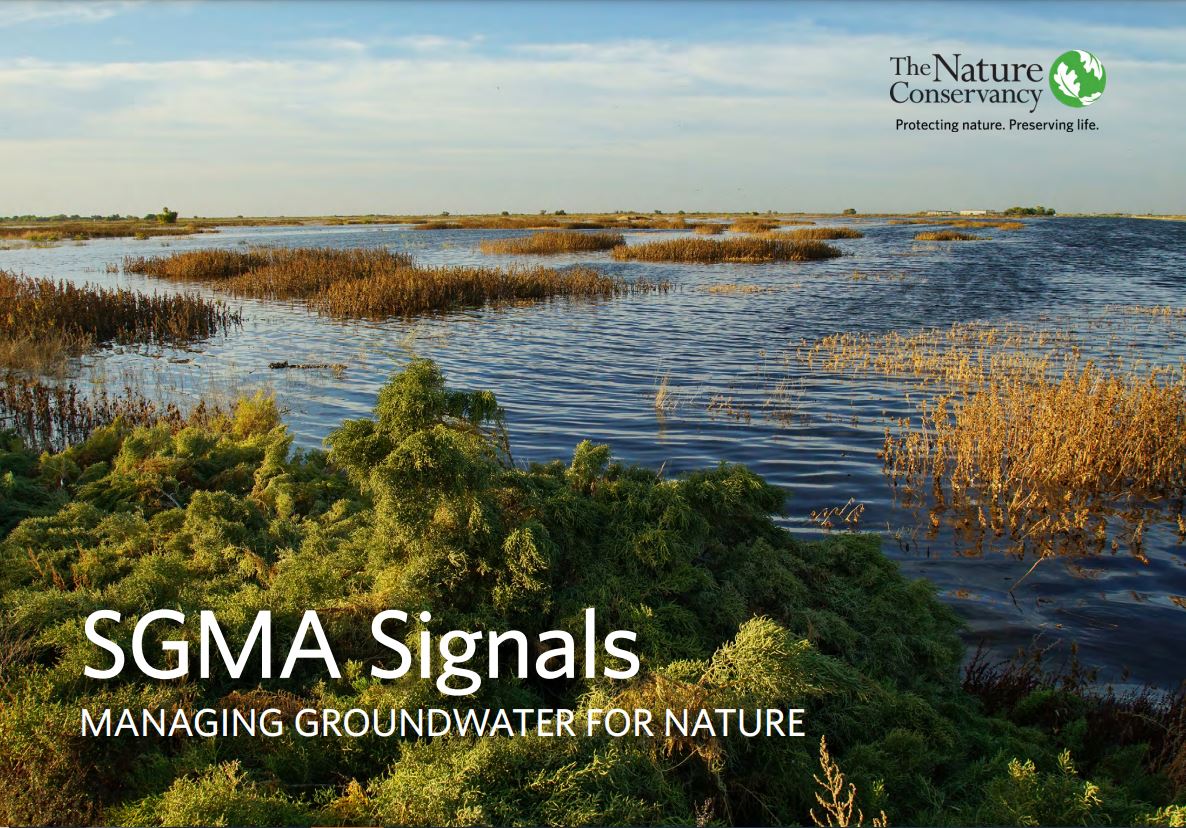Advancing Sustainable Groundwater Management for California
Sustainable groundwater management means managing this resource to balance short-term and long-term benefits for society, the economy and our environment. To help ensure that the needs and benefits of managing for GDEs are known, The Nature Conservancy is working with its partners to develop the science on nature’s ties to groundwater and showcase multi-benefit management strategies for nature and people.
- Switch to:
- Projects
- Tools
- Reports & Resources
- Contact Us
We may not be able to see groundwater, but it’s vital to life in California.
Groundwater is critically important to people, supplying 40 percent of California’s water supply in normal years and up to 60 percent in times of drought. It is also essential in sustaining many types of plants and animals, from those found in mountain and desert springs to coastal wetlands.
By maintaining sufficient groundwater levels and the critical connections between groundwater and surface water, we can balance the needs of GDEs and people. Protecting GDEs requires an understanding of where they are located, how they rely on groundwater, and how changing groundwater conditions can affect them. Identifying and considering GDEs in groundwater sustainability plans (GSPs), along with routine monitoring, can help ensure they are not harmed by unsustainable use of groundwater.






Strategic Restoration
TNC is working with partners to reduce groundwater pumping by retiring and restoring farmlands in the San Joaquin Valley. Learn more about Strategic Restoration at TNC CA.
Groundwater Markets
Groundwater Markets give individual pumpers control over their respective paths toward a basin’s sustainable yield to incentivize conservation and markets may be a valuable tool for GSAs as they implement their plans. Learn more about TNC CA’s work on Water Markets.
Multi-Benefit Recharge
Groundwater recharge will be an important tool for GSAs to use for achieving long-term groundwater sustainability. Learn more about TNC CA’s work on Multi-Benefit Recharge.
-

GDE Pulse
GDE Pulse lets you see how California’s unique groundwater dependent ecosystems have changed over the last 30 years. Access GDE Pulse Here
-

ICONS Tool
The ICONS dataset provides information on the depth to groundwater and the likely presence of interconnected surface water (ISW) in the Central Valley. Access the ICONS Tool Here
-

California Natural Flows Database
The California Natural Flows Database is a new TNC tool predicting natural flows across California. Access the Natural Flows Database Here
SGMA Resources
Learn more about SGMA through the TNC reports and resources below.
-
Achieving Groundwater Access for All
PDF
This report analyzes the degree to which groundwater plans equitably integrate and protect vulnerable groundwater users, and suggests course corrections in the ongoing process to ensure we are preparing our groundwater basins for a changed climate. Learn More about Groundwater Access for All.
DOWNLOAD -
SGMA Signals
PDF
How well did the first 30 Groundwater Sustainability Plans submitted account for nature’s needs? TNC's SGMA Signals Report finds that nearly all GSPs have room for improvement. Learn more about SGMA Signals.
DOWNLOAD -
Mapping Indicators for GDEs
PDF
This methods report is a guide on how to validate the groundwater dependency of “indicators of groundwater dependent ecosystems (iGDEs)” with local information. Learn more about Mapping Indicators.
DOWNLOAD -
GDEs Under SGMA
PDF
This is a step-by-step guide that fits within the overall planning process established by SGMA. Find more GDE Guidance Here.
DOWNLOAD -
GDE Checklist for GSPs
PDF
The Nature Conservancy is providing this checklist as guidance for GSAs to adequately address nature in their GSPs, as required under SGMA. Following this checklist does not guarantee approval of a GSP.
DOWNLOAD -
Mind the Gaps
PDF
“Mind the Gaps: The Case for Truly Comprehensive Sustainable Groundwater Management” is a joint report that points out the gaps in the Sustainable Groundwater Management Act (SGMA) and makes the case for the expansion of SGMA statewide.
DOWNLOAD
GSP Comments
TNC is providing comments on draft Groundwater Sustainability Plans (GSPs) as a representative stakeholder of the environment. The comments are intended to ensure the Groundwater Sustainability Agencies (GSAs) adequately address nature in their GSPs, as required under SGMA.
GDE Resources
Learn more about GDEs through the TNC reports and resources below.
-
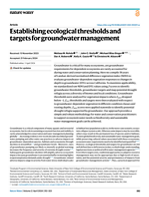
Ecological Thresholds for GDEs
PDF
A recent article published in Nature exploring thresholds for GDEs. The article compiled 38 years of Landsat-derived normalized difference vegetation index (NDVI) to evaluate groundwater-dependent vegetation responses to changes in depth to groundwater (DTG) across California.
DOWNLOAD -
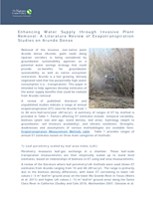
Arundo Literature Review
PDF
Arundo is a non-native, fast growing and densely vegetated reed that has purportedly high-water consumption. This brief literature overview summarizes the types of studies, conditions, and annual evapotranspiration rates of Arundo.
DOWNLOAD -
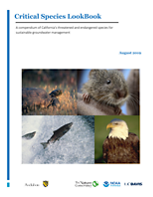
Critical Species Lookbook
PDF
The Critical Species LookBook is a compendium of 84 state and federally listed species that are likely to be affected by groundwater management and merit consideration by Groundwater Sustainability Agencies (GSAs) under the Sustainable Groundwater Management Act (SGMA). Learn more about the Critical Species LookBook.
DOWNLOAD -
Plant Rooting Database
Excel
The Plant Rooting Depth Database provides information that can help assess whether groundwater-dependent vegetation are accessing groundwater. Learn more about the Plant Rooting Depth Database.
DOWNLOAD -
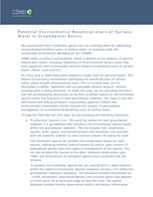
Environmental Surface Water Beneficial Users
PDF
Review recommendations on potential environmental beneficial users of surface water. The Nature Conservancy is also providing a list of freshwater species located within each groundwater basin in California, which can be accessed here.
DOWNLOAD -
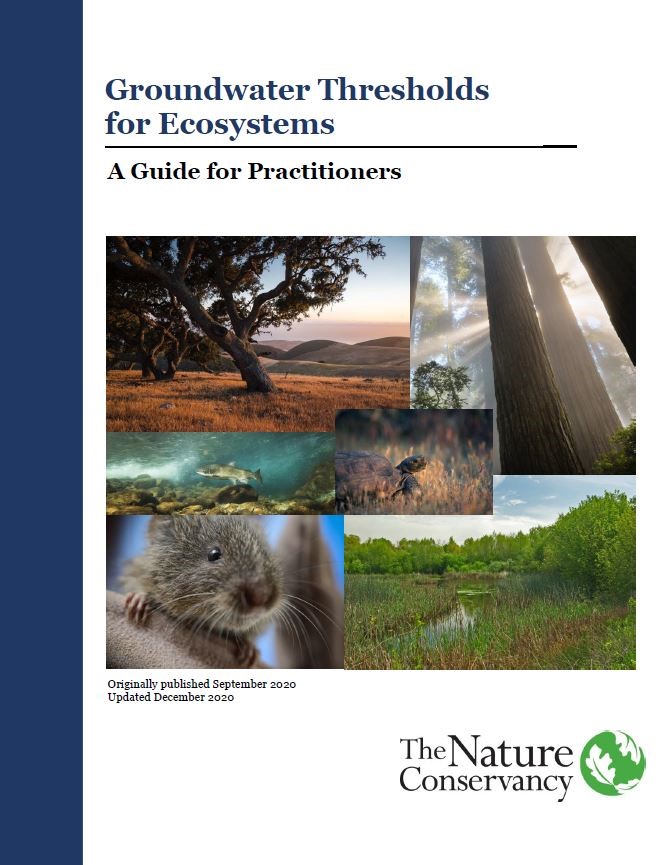
GDE Thresholds Framework
PDF
This publication presents a practicable approach for quantifying groundwater conditions that are protective of GDEs. This document highlights five steps to quantify what groundwater levels are needed to avoid adverse impacts from groundwater use on GDEs.
DOWNLOAD
If you have questions or comments about anything you see here on the Groundwater Resource Hub, please send an email to gwrhubcontactus@tnc.org, or contact any of our staff listed below.
Abby Hart
Project Director, Rewilding the Central Valley, Water Program
abigail.hart@tnc.org
Caitrin Chappelle
Associate Director, Healthy Rivers & Springs, Water Program
c.chappelle@tnc.org
Charlotte Stanley
Conservation Technology Associate
c.k.stanley@tnc.org
E.J. Remson
Sr. Project Director, Healthy Rivers & Springs, Water Program
eremson@tnc.org
Julie Zimmerman
Science Director, Water Program
julie.zimmerman@tnc.org
Julia Barfield
Project Manager, Rewilding the Central Valley, Water Program
jbarfield@tnc.org
Kirk Klausmeyer
Sr. Spatial Data Scientist
kklausmeyer@tnc.org
Nick Murphy
Groundwater Scientist, Healthy Rivers & Springs, Water Program
nicholas.murphy@tnc.org
Ryan Luster
Sr. Project Director, Rewilding the Central Valley, Water Program
rluster@tnc.org
Sandi Matsumoto
Director, Water Program
smatsumoto@tnc.org

